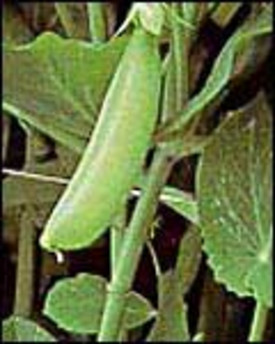 |
||
|
|
According to old Celtic folklore, it’s when one can sit naked on the ground. Our Pilgrims, not given to bawdy rites of spring devised their own test. According to New England lore, it’s when a fistful of soil crumbles instead of congealing into a mudball. The Pilgrims’ test spread across this continent, rather than the more interesting Celtic one.
However, according to agriculture experts, plant the peas when the soil is warm enough for the seed to sprout (between 45°F and 75°F), yet still early enough to produce a crop before the heat of summer which ruins the plant.
Peas grow best in cool spring weather. If the soil is too wet or cold at planting time, the seeds get fungus and rot or barely grow if they sprout. With warmer soil, germination and growth are faster. But come the heat of summer, they stop producing a good crop. Traditionally, on July 4th, one serves salmon with fresh picked peas.
Some Tricks for Growing Peas. To help capture that small perfect window in time for planting, warm the soil by covering the seed bed with perforated plastic sheeting. It also hastens germination and growth plus discourages rabbits from nibbling the new shoots. Perforations allow water and air to reach the plants. A plastic milk jug, with the top and bottom cut off will do the same.
To retard fungus in cold soil, coat the seeds with a fungacide. (For powdered fungacides, shake it with the seeds in a paper bag.) As members of the legume family, pea roots require nitrogen-fixing bacteria in the soil. This innoculent can be bought as a black powder and dusted on the seeds in their packet. Plant the seeds l” deep and 2″ apart. Seeds remain viable for about 3 years.
Peas need something to climb on. Movable wire fencing works well and then can be used for tomatoes when the peas are done. Naturally add fertilizer to the planting beds and bring the pH to 6. But don’t cultivate heavily if the soil is damp. It ruins the texture. When pods first appear in June, apply a side dressing of fertilizer, or give a liquid foliar feeding.
For a tender, sweet crop, keep peas growing fast by irrigating as needed. Avoid drought and hot feet which makes them stringy, tough and tasteless.
 |
|
|
|
Harvesting. Pick peas frequently…ideally while the cooking water is boiling. Pea sugar changes to tasteless starch very quickly. To preserve sweetness, immediately freeze any extras in plastic bags. Don’t overcook.
Plant Different Varieties For a Longer Harvest. Different peas bear at different times between 55 and 70 days from sprouting, so plant several kinds. An fine heirloom variety (1898) is Thomas Laxon, which bears in 60 days. Micro (67 days) produces little “baby” peas, while Arise is very early (55 days). Wando (68 days) is more tolerant of cold sowing and warm weather.
We like edible pods like the big old fashioned Mammoth Melting Sugar Edible-pod, or giant Chinese Snow Pea. Good stir-fried. The newer sugar snap varieties are not as tall, remain stringless longer and will produce regular peas if not harvested early as pods. Some of the newer varieties are also virus and disease resistant.
Credit: Mother’s Garden




























